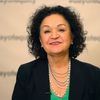Every responsible funder must consider the question of what it means to be a good steward of the assets with which we have been entrusted -- to ensure that our capital grows so that we can continue to offer support to our grantees.
Equally important is the underlying question of what, exactly, that "capital" comprises. In light of our central goals as funders -- in Marguerite Casey Foundation's case, to support a movement of low-income families -- what is the greatest value we bring to the table?
Over the past several years, Marguerite Casey Foundation and its grantees have engaged with low-income families across the country in an effort to spark and support a family-led movement under the banner of Equal Voice for America's Families.
Through that work, I have come to think about capital differently. There is no question that capital as it is traditionally defined -- the financial assets that allow us to make grants and help build the infrastructure for this national movement -- is central to our work. But social capital is an equally crucial, albeit less recognized, asset.
Through the collective work of Equal Voice, a grantmaking strategy that supports a network of relationships across the country, people from vastly different backgrounds were connected by shared values and common dreams.
Without the social capital that network represents, our current goal -- to harness the energy generated by the Equal Voice into a lasting, family-led membership-based organization -- would be out of reach.
If one measures the value of an asset not just by the size of a number on a spreadsheet but by the change that asset can leverage in the world, the value of social capital comes into focus.
And, with that shift in perspective comes a powerful, if humbling, realization: As hard as we at Marguerite Casey Foundation and our grantees work to support a movement and even build an organization to sustain it -- it is the families, not us, who will ensure its success. Equal Voice is not "ours" at all. It belongs to the families -- and to those who will join them to grow the movement and the organization as they see fit.
When it comes to reconceiving the role foundations can play in supporting social change, this is the point where the rubber meets the road. Social change philanthropy as practiced to date has often revolved around investing in nonprofit groups striving to achieve social and economic equity, often by organizing communities that have the most at stake.
What we learned from the tens of thousands who participated in the 2008 Equal Voice campaign is that families across America are ready to flip the script -- that is, to become their own leaders, organizing their own communities around their own priorities.
A member of the Equal Voice Family Advisory Committee was even more explicit, "People are always saying they want to hear what we have to say," she said, "unless what we say is not what they want to hear." How many times have we as philanthropists heard similar comments? How many times have we decided that we know best?
It is easy to feel defensive in the face of this kind of honesty. But uncomfortable truths are often the most profound. If we truly aim to flip the script, that may require questioning, for example, the notion of asking families to advise us on our efforts on their behalf. What might happen if we asked instead what we could do to support their efforts, as they defined them?
There is no question that families have the ability to define their own issues. The challenge for those of us in philanthropy who believe in the power and potential of a family-led movement is finding our role -- a process that will inevitably include relinquishing control.
Providing financial support is essential, but is it sufficient? What more will it take to create opportunities for poor and low-income working Americans to advocate on their own behalf, without the traditional mediators (including, it must be acknowledged, ourselves)?
That is the central question, and with it the key conundrum: how to do all we can, without doing too much; how to help move the family agenda forward even as we step back, opening space for family leaders to step up?
Reframing movement building as an endeavor in which those most affected take the lead rather than being "organized" by others is a challenging enterprise. It challenges us as funders; it challenges the community organizations that make up the majority of our grantees; and, ultimately, it challenges our political system.
My own prediction is that philanthropy will be called to do not more but a very strategic less -- to act on our values by relinquishing power, offering not our leadership but simply our support to the new wave of family leaders who will set the agenda for generations to come.
